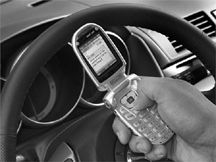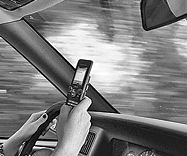The train accident in Los Angeles is a reminder of our responsibilities that come with technology. The engineer was texting during the time immediately leading to the accident, causing multiple tons of steel colliding. While most of us don't drive a train, our cars are much more dangerous because they are free of tracks.
Technology has always fascinated us. We cannot wait to experience the latest gadgets available out there. Our enthusiasm towards these innovations is such because their use can make life easier. Furthermore, most of these devices allow us to do more within a relatively shorter period of time.
The cellular phone, in particular, is one technological wonder that most of us are obsessed with because it gives us the ability to communicate almost anywhere we are. There is that feeling of freedom, not being tied down with wires. At the same time there is also that feeling of accomplishment because we can connect while doing some other activity.
But this ability to multitask because the technology is there should be coupled with a sense of responsibility, most especially when life and limb are at stake.
Investigators in last week’s train crash in Los Angeles are looking at strong evidence that the engineer was texting while on board. The accident claimed the lives of 25 people, including the engineer’s. In response, California lawmakers are pushing to ban train operators from using cell phones while on duty.
In a recent online survey, almost 50% of young motorists admitted to texting while driving.
Still another survey, this time conducted across the U.S., revealed that at least 20% of adults text while behind the wheel. The figure is even higher for younger drivers. What is alarming, though, is that DWT or Driving While Texting is perfectly legal in most parts of the country.
Driving requires attention and focus. It involves working the pedals, gear shift, and steering wheel. There should be coordination between the eyes, hands and feet. So if someone is trying to do something else like texting while driving, then that person’s attention and focus are diverted. Coordination is disrupted and errors are most likely to be committed which could lead to an accident.
Around 80% of the information received and needed by a driver comes through his eyes. The person operating the vehicle should be able to see, not only straight ahead, but he must also take note of objects in his peripheral vision. The simple act of looking away from the road for a few seconds triples the risk of car crashes. This is because a lot can already happen during that small amount time.
As a driver looks back at the road ahead after reading a text message, his vision is most concentrated on what is directly in front of him. His eyes refocus and he might not be able to react quickly enough when, for example, a fast-moving vehicle approaching from the side crosses his path.
Loss of focus on the road ahead may lead to loss of control as well. Holding a cell phone in one or both hands, and trying to steer at the same time is a trick that a lot of drivers have mastered; or so they think. Some will say that it’s just like having cup of coffee while driving to work. But texting will have you punching the phone’s keypad too. Proper steering requires that you properly hold the wheel using a moderate grip, with both hands.
In unexpected situations when changing direction, shifting gears, slowing down, or coming to a full stop is required, full control is important. A driver going 20 mph while texting might not be able to swerve or stop in time when a pedestrian crosses the street a few meters in front of him.
Text messaging is only an alternative to calling. Keep this in mind when you’re driving and get a text message. It would be a good idea to tell family, friends and acquaintances that, if their message is important enough, then they should call you instead of just texting. As regards voice calls when driving, most modern cell phones now have a hands-free feature. Use it.
As of July this year in the state of California, talking on your cell phone while driving is considered illegal unless you use a hands-free kit.
If you absolutely have to read that text message, take advantage of traffic stops. At red lights, put the car in neutral and apply the handbrake. Or just pull over in a safe area to read your messages.
If you’re driving with someone, let them read the message to you. You can also have the other person type and send the text reply for you.
The need for connectivity has always existed. Because of technology, that need has continually been addressed. Similarly, because technology is there, we feel the need to use it, to connect more often so as to take advantage of every available innovation. The two seem to be feeding on one another. But in these modern times when technology allows us to multitask, it would be good to have a dose of common sense and discipline above everything else.


